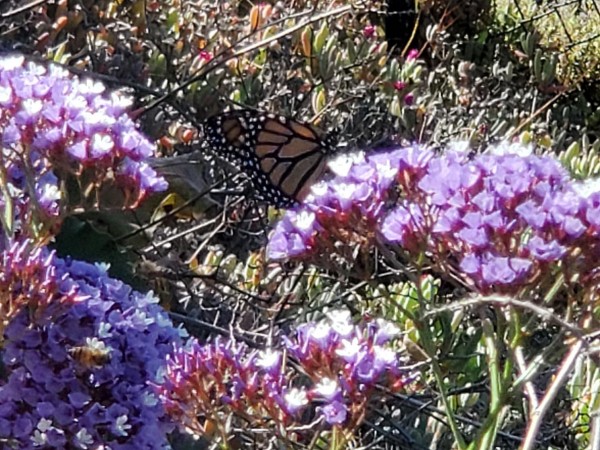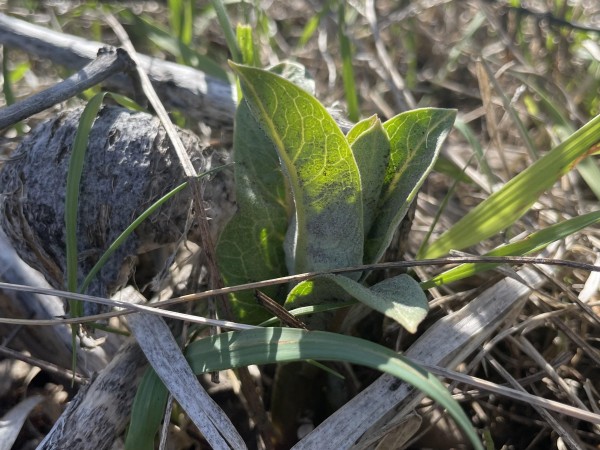Letter from Gail Morris: Western Monarch Spring Report #10
Published: 05/05/2021
Dear Western Monarch Friends,
Reports this week noted little movement of monarchs in California, but their numbers increased slowly in Arizona and New Mexico. Everyone is watching closely for the first sighting in Utah as warm and breezy weather continues to bathe the region.
California
Monarch sightings appeared around familiar areas but several people still reported their first sighting of the season.
William saw one monarch in Oakland on April 27, “Monarch sighted among the Zinnias.”
Denise saw her first monarch of the season in Pittsburg on April 30, “First one spotted. Flying low over lawn. Outer wings looked faded. Beautiful warm day.”
Further south, Marie in San Diego reported one monarch on April 30. “Saw this Monarch at 9:21 am on Limonium perezii, Sea Lavender, in my yard.”
Hope in Long Beach found eggs and larvae in her yard. “We saw our first monarch butterfly on 4/29. We noticed 6 monarch eggs on our milkweed plant on 4/30. We currently have 10 monarch caterpillars.”
William was lucky to find 4 monarchs on May 1 in Camarillo. “Feeding and laying eggs.”
On the same day Diane found two monarchs in Orange. “Saw 2 adult monarch and one chrysalis a week old.”
Arizona
After a warm week, last weekend 2-4 inches of snow graced the higher elevations of Arizona like Flagstaff but there were still new sightings along the Colorado River.
On April 24 Mary Lou saw one monarch in Lake Havasu, “By pool and flowers.”
Marissa in Chandler on May 4 spotted one, too. “A single monarch flying around and landing several times on my okra leaves.”
New Mexico
There have been several sightings in the northern region of the state but this week Mary in Embudo saw one on the wing on April 27, “Flying over a pasture.”
Milkweed Up
Larry in Jerome, Idaho, on April 29 found two areas with milkweed just breaking ground. “Two locations: one on canal bank and other in flower bed.”
Meanwhile Bradford in Meridian, Idaho reported milkweed just emerging on May 2. “Asclepias speciosa. First shoots. Seed pod seen is from September 2020.”
Is This Butterfly a Monarch or a Queen?
By May, the monarch’s closest relatives, Queen butterflies, Danaus gilippus, are often seen flying with monarchs. They are in the same genus and both use milkweed as their only host plant, so you will likely find queens when you are out looking for monarchs. Take a few moments to look at their similarities and also their differences. Monarchs only have white dots in the black parts of their wings, so when you see the white dots in their orange upper wings it is an easy identifier that you have a queen.
Send in your reports!
The lower deserts will flirt with their first 100°F temperatures this week, likely encouraging monarchs to continue north and east to cooler locations. Be sure to take your camera or phone along on your neighborhood stroll or hike and tell us what you see. Your reports can help everyone know the “status of the breeding habitat” where you live. Don’t forget to report milkweeds up, flowers in bloom and, of course, any monarchs you see! Remember, monarchs may lay eggs on milkweed before they flower so other nectar resources are important. A photo from your phone or camera can help us all see the progress early monarchs are now making in the spring migration. Warm weather and southerly winds can help monarchs move into your area! Be sure to watch windy.com frequently to see when winds favor monarch movement in your area. Where will monarchs fly this week?
Gail Morris is the Coordinator of the Southwest Monarch Study (www.swmonarchs.org), a Monarch Watch Conservation Specialist, and the Vice President of the Monarch Butterfly Fund and the Central Arizona Butterfly Association. The Western Monarch Population News is based on comments provided to Gail Morris. We hope to increase the number of sightings and therefore photos and comments entered into the Journey North. We rely on the volunteers who communicate regularly with Gail and who agree to participate in our effort to increase awareness of the population of western Monarchs. You can reach her at gail@swmonarchs.org.


